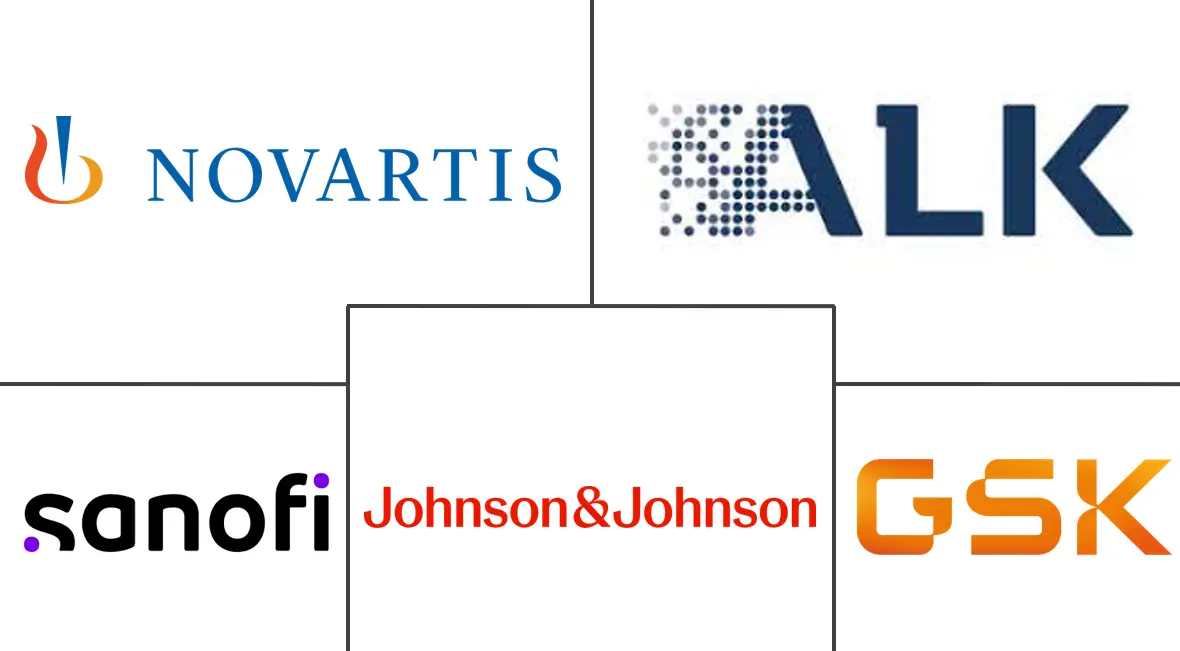Allergy Treatment Market Size and Share
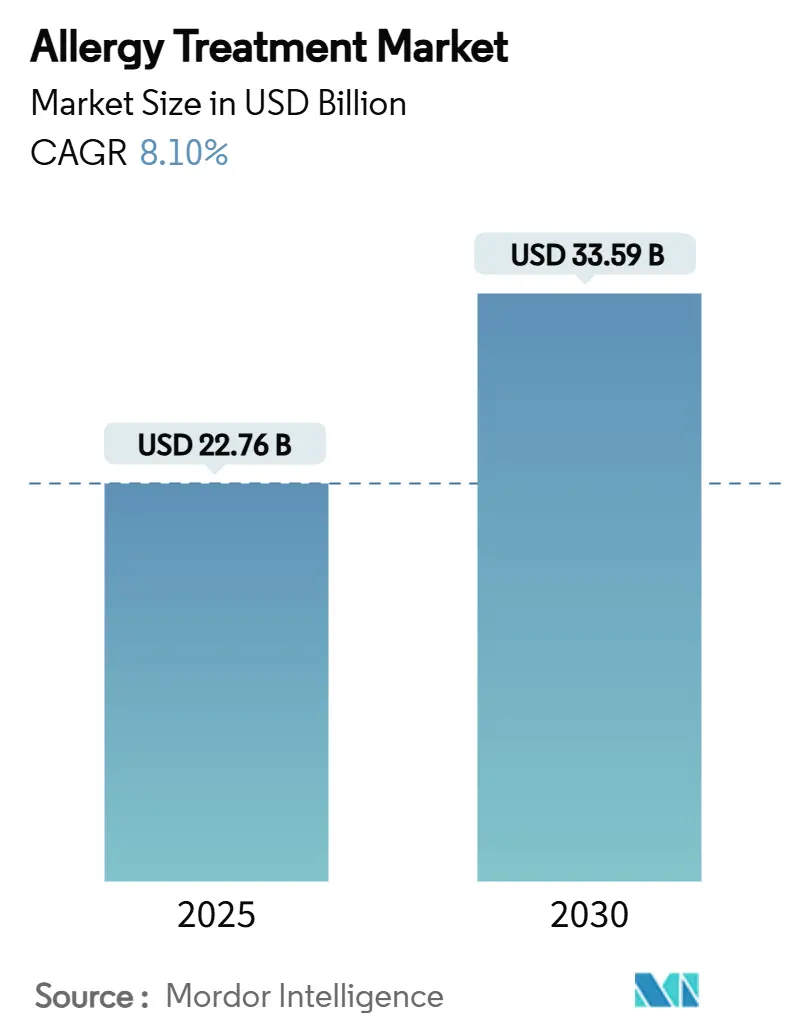
Allergy Treatment Market Analysis by Mordor Intelligence
The global Allergy treatment market size reached USD 22.76 billion in 2025 and is projected to advance to USD 33.59 billion by 2030, registering an 8.10% CAGR during the forecast period. Accelerated disease prevalence, climate-driven allergen amplification, and breakthrough biologics are collectively lifting demand, while new digital-health models broaden access and adherence. Competitive intensity has sharpened since omalizumab won the first multi-food indication, drawing both large pharmaceutical firms and nimble biotech entrants into direct rivalry. Regulatory initiatives that speed biosimilar substitution add price pressure yet simultaneously stimulate innovation in delivery technology, immunotherapy personalization, and patient-centric care. Geographic divergence remains pronounced: North America sustains spending leadership on biologics, whereas Asia-Pacific records the fastest uptake of immunotherapy as urbanization deepens sensitization levels.
Key Report Takeaways
- By allergy type, rhinitis held 41.51% of Allergy treatment market share in 2024; food allergy is forecast to expand at a 9.65% CAGR through 2030.
- By treatment, anti-allergy drugs dominated with 65.53% share of the Allergy treatment market size in 2024, while immunotherapy is poised for a 10.85% CAGR to 2030.
- By dosage form, tablets and capsules commanded 42.62% of the Allergy treatment market size in 2024; injectables and auto-injectors exhibit a 10.35% CAGR over 2025-2030.
- By distribution channel, hospital pharmacies led with 35.25% Allergy treatment market share in 2024; online pharmacies are projected to post an 11.55% CAGR to 2030.
- By geography, North America accounted for 38.25% Allergy treatment market share in 2024, whereas Asia-Pacific is advancing at a 9.85% CAGR during the forecast horizon.
Global Allergy Treatment Market Trends and Insights
Drivers Impact Analysis
| Driver | (~) % Impact on CAGR Forecast | Geographic Relevance | Impact Timeline |
|---|---|---|---|
| Rising prevalence of allergic rhinitis & asthma | +1.5% | Global, strongest in Asia-Pacific megacities | Medium term (2-4 years) |
| Increasing patient preference for self-medication & OTC drugs | +1.2% | North America and Europe, spreading to emerging markets | Short term (≤2 years) |
| Growing investments in novel therapeutics & biologics | +0.8% | Global, concentrated in developed regions | Long term (≥4 years) |
| Expansion of online-to-home SLIT tele-care platforms | +0.6% | North America & Europe, early adoption in urban Asia | Medium term (2-4 years) |
| Commercialisation of anti-IgE monoclonal antibodies | +0.4% | Global, led by North America & Europe | Short term (≤2 years) |
| Climate-induced allergen-load amplification | +0.3% | Global, acute in temperate regions | Long term (≥4 years) |
| Source: Mordor Intelligence | |||
Rising Prevalence of Allergic Rhinitis & Asthma
Surging urban air pollution fuels oxidative stress that flips immune responses toward a TH2 profile, anchoring demand for prescription antihistamines, leukotriene antagonists, and biologics in the Allergy treatment market. Megacities from Beijing to Delhi report sensitization rates exceeding 50%, while cost burdens in the United States already surpass USD 3.4 billion annually. The global scope of rhinitis, affecting up to 30% of adults and 40% of children, makes it the single largest patient pool and a reliable revenue base.
Increasing Patient Preference for Self-Medication & OTC Drugs
Better tolerated second-generation antihistamines and intranasal corticosteroids have migrated from prescription to OTC status, widening consumer reach and lifting overall transaction volumes in the Allergy treatment market. Retail shelf prominence aligns with digital symptom checkers, steering mild sufferers toward self-directed care and decongestant combinations. Short diagnostic wait times in community pharmacies further cement this behavior, especially across North America and Western Europe.
Growing Investments in Novel Therapeutics & Biologics
Capital allocation into IgE, cytokine, and alarmin-targeting antibodies has intensified after FDA cleared omalizumab for multiple food allergies in February 2024. Sanofi’s USD 9.1 billion acquisition of Blueprint Medicines in June 2025 underscores pharma’s appetite for specialized immunology assets. Pipeline candidates like depemokimab, ligelizumab, and UB-221 promise competitive step-ups in potency and combinability, bolstering the long-term growth runway for the Allergy treatment market.
Expansion of Online-to-Home SLIT Tele-Care Platforms
Tele-immunotherapy adoption leapt from 15.4% pre-pandemic to 87% during lockdowns, and sustained usage evidences a structural channel shift. Artificial-intelligence forecasts of pollen trends prompt real-time dose titration, while pharmacy-benefit listing of SLIT tablets eliminates complex medical billing barriers. Comparable efficacy to subcutaneous immunotherapy and the absence of injection-site reactions encourage adherence, driving incremental revenues for the Allergy treatment market.
Restraints Impact Analysis
| Restraint | (~) % Impact on CAGR Forecast | Geographic Relevance | Impact Timeline |
|---|---|---|---|
| Escalating uptake of low-cost biosimilars eroding price/margins | -0.9% | Global, strongest in Europe & emerging markets | Short term (≤2 years) |
| Low patient & HCP awareness of AIT long-term benefits | -0.7% | Global, acute in low-resource regions | Medium term (2-4 years) |
| Limited reimbursement for biologic & SLIT therapies | -0.5% | North America & Europe | Medium term (2-4 years) |
| Supply-chain risk for natural allergen extracts | -0.3% | Global, clustered in specialized hubs | Long term (≥4 years) |
| Source: Mordor Intelligence | |||
Escalating Uptake of Low-Cost Biosimilars Eroding Price/Margins
Interchangeable omalizumab and a wave of ustekinumab biosimilars cut unit prices by up to 40%, compressing top-line growth for originators within the Allergy treatment market[1]Medical Letter, “Omlyclo — An Omalizumab Biosimilar Interchangeable with Xolair,” medicalletter.org. Europe’s tender systems hasten penetration, while emerging economies embrace cost-relief as gateways to biologic access. Originators respond with device upgrades and real-world-evidence dossiers to justify premium positioning.
Low Patient & HCP Awareness of AIT Long-Term Benefits
Sublingual and subcutaneous immunotherapy confer disease-modifying advantages, yet variability in practitioner training and public messaging leaves uptake below potential, particularly across Latin America and parts of Africa.
Segment Analysis
By Allergy Type: Rhinitis Dominance Drives Market Leadership
Rhinitis contributed 41.51% to the Allergy treatment market share in 2024, capitalizing on its high global prevalence and multi-modal therapy toolkit. Over-the-counter antihistamines, intranasal corticosteroids, and SLIT tablets form the therapeutic spine, while biologics gain traction in severe poly-sensitized cohorts. Seasonal and perennial variants jointly sustain an expansive prescription base, guaranteeing baseline demand regardless of emergent treatment classes.
Food allergy, the fastest-growing segment at 9.65% CAGR to 2030, benefits from the first disease-modifying biologic clearance and a broad pipeline of oral immunotherapy combinations. Epidemiological recognition of adult-onset allergy enlarges eligibility pools, and school-based anaphylaxis protocols amplify prophylactic prescriptions. Eye, skin, asthma, and other niche allergies round out the segment landscape, each adding volume through fortified diagnostic vigilance and cross-indication biologic use.
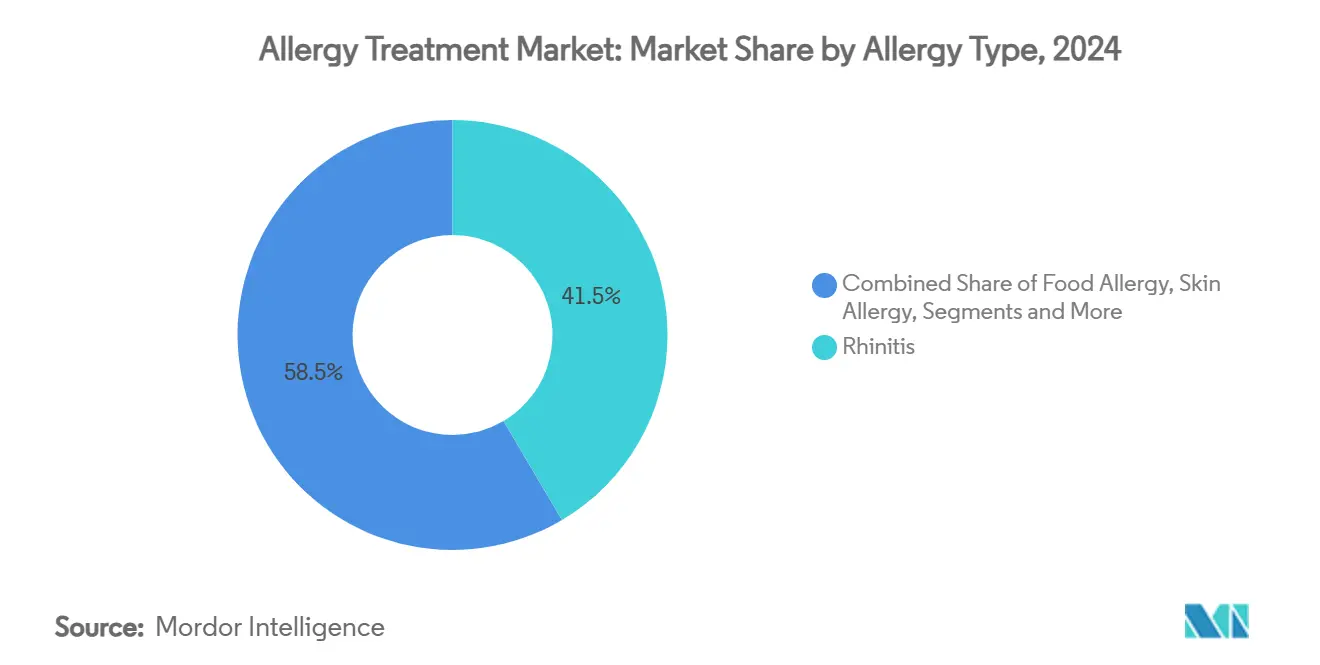
Note: Segment shares of all individual segments available upon report purchase
By Treatment: Immunotherapy Acceleration Challenges Drug Dominance
Anti-allergy drugs maintained 65.53% of the Allergy treatment market share in 2024, bolstered by favorable reimbursement, OTC prominence, and maturing generics. Second-generation antihistamines, topical corticosteroids, and leukotriene blockers together form a stable revenue stream that cushions price swings in novel categories.
Immunotherapy is slated for a 10.85% CAGR through 2030, reflecting payer recognition of long-term cost efficiency and rising patient preference for home-based SLIT regimens. Clinical guidelines standardize dosing and duration, minimizing variability and elevating clinician confidence. Subcutaneous protocols remain the gold standard for maximized efficacy in high-risk patients, while combination biologic-SLIT strategies emerge for complex multi-sensitizations, strengthening the Allergy treatment market size proposition.
By Dosage Form: Injectable Innovation Disrupts Tablet Leadership
Tablets and capsules held 42.62% of the Allergy treatment market size in 2024 owing to manufacturing scalability, patient familiarity, and straightforward regulatory pathways. Their stronghold persists in OTC antihistamines and prescription leukotriene antagonists, yet innovation is gradually steering high-value therapy toward parenteral formats.
Injectables and auto-injectors are projected to climb at a 10.35% CAGR, energized by monoclonal antibody expansion and needle-free innovations such as ARS Pharmaceuticals’ nasal epinephrine spray that sidesteps needle phobia[2]European Medicines Agency, “Eurneffy | European Medicines Agency,” ema.europa.eu. Nasal sprays and inhalers maintain relevance through localized delivery precision, while smart-inhaler add-ons improve adherence tracking in asthma overlap cases.
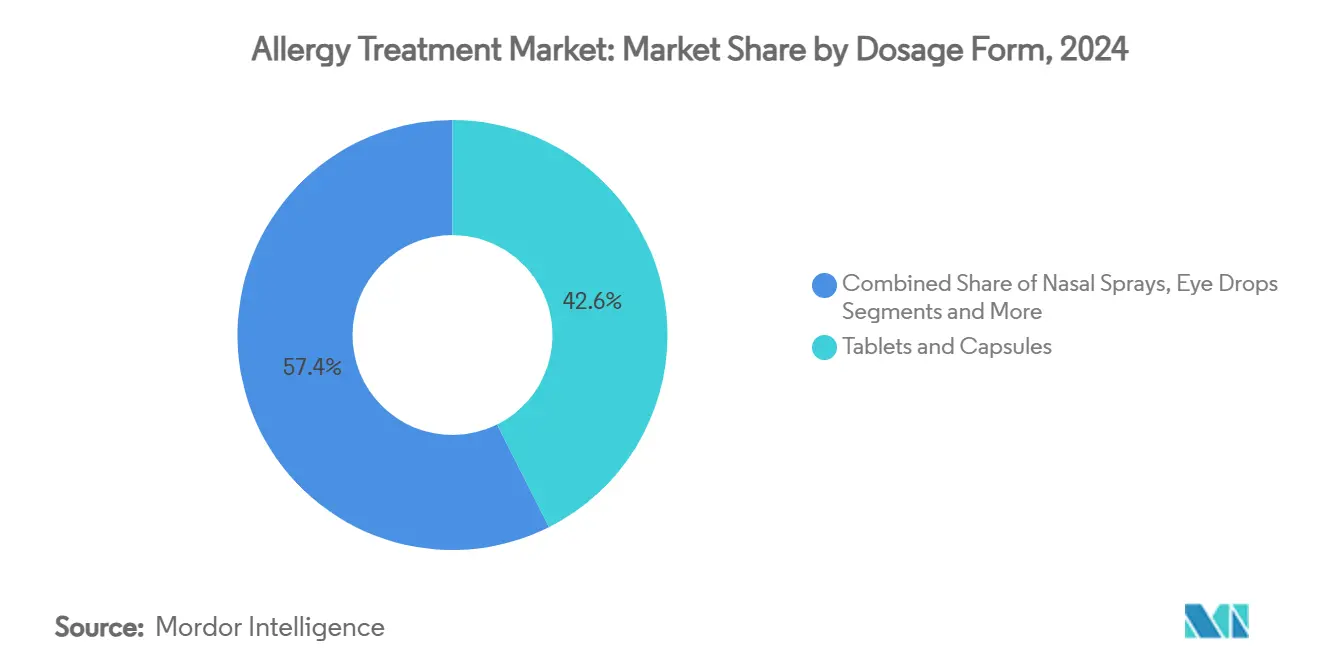
Note: Segment shares of all individual segments available upon report purchase
By Distribution Channel: Digital Transformation Accelerates Online Growth
Hospital pharmacies retained 35.25% Allergy treatment market share in 2024, anchored by biologic initiation protocols that require clinical oversight. Risk-mitigation strategies for anaphylaxis during first-dose administration mandate observation facilities, reinforcing hospital dominance.
Online pharmacies are expected to expand at 11.55% CAGR, assisted by e-prescribing, tele-consultation integration, and last-mile cold-chain logistics upgrades. Digital refill calendars and AI-driven adherence nudges enhance patient convenience, supporting chronic therapy retention and widening the Allergy treatment market. Retail and specialty pharmacies occupy the continuum between hospital control and direct-to-door models, diversifying channel resilience.
Geography Analysis
North America’s 38.25% Allergy treatment market share in 2024 stems from extensive insurance coverage, early biologic adoption, and concentrated specialist networks[3]U.S. Food and Drug Administration, “FDA Approves First Medication to Help Reduce Allergic Reactions to Multiple Foods After Accidental Exposure,” fda.gov. The United States spearheads regulatory firsts that propagate to other regions, positioning domestic manufacturers for early revenues and prolonging lifecycle advantages. Biosimilar penetration remains moderate given substitution hesitancy and REMS constraints, preserving price integrity for innovators.
Asia-Pacific’s 9.85% CAGR through 2030 outpaces all other regions, driven by urbanization-linked sensitization surges, rising disposable incomes, and expanded public-health insurance that covers select immunotherapies. House-dust-mite sensitization exceeds 90% in atopic cohorts, steering demand for region-matched allergen extracts and fueling collaborative distribution deals such as ALK-Abbello’s tie-up with Abbott. Mobile-first healthcare adoption accelerates SLIT tele-care in metropolitan clusters, broadening therapy reach.
Europe shows mature penetration but faces price compression under biosimilar-friendly tender frameworks. The region leads standardization of immunotherapy quality and pharmacovigilance, contributing to sustainable but restrained revenue growth. Middle East & Africa and South America present emergent opportunities with gradually improving specialty-care infrastructure, though economic and supply-chain volatility temper near-term traction.
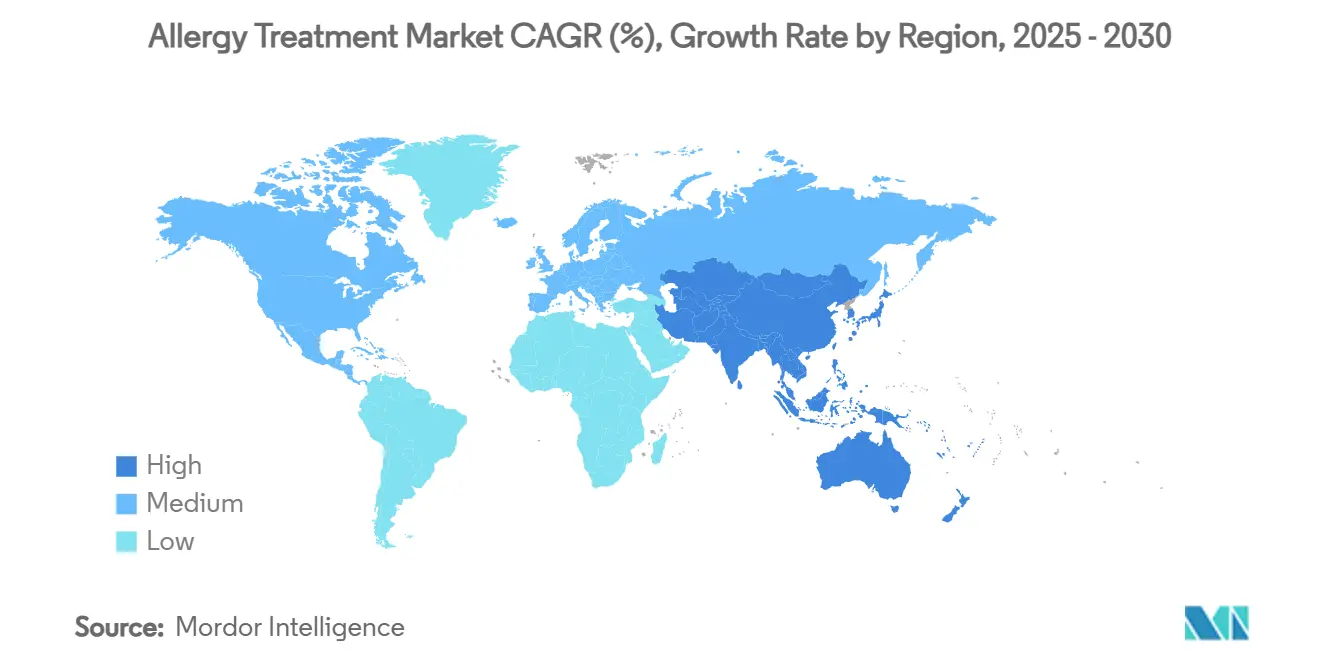
Competitive Landscape
The Allergy treatment market is fragmented. Top incumbents such as GSK, Novartis, and Sanofi blend incipient biologics with entrenched antihistamines to hedge lifecycle risks. ALK-Abbello and Stallergenes Greer dominate allergen-extract supply and SLIT commercialization, while Celltrion’s Omlyclo biosimilar demonstrates the disruptive force of interchangeability.
Device innovation gains prominence. ARS Pharmaceuticals secured EMA clearance for the first nasal epinephrine spray, removing injection barriers and spotlighting patient-centric design. Biotech challengers leverage virus-like particle technology to re-engineer immunogenic profiles, as illustrated by Angany’s eBioparticle platform. Digital therapeutics and AI-predictive engines differentiate service portfolios, deepening competitive moats around adherence outcomes and real-world evidence.
Strategic deals dominate the newsflow. Sanofi’s Blueprint buyout adds KIT inhibitors to an already formidable immunology armamentarium, while alliances between global pharma and regional distributors unlock emerging-market penetration. R-and-D partnerships de-risk early biologic assets, spreading capital exposure and accelerating time-to-market in the Allergy treatment market.
Allergy Treatment Industry Leaders
-
Johnson & Johnson
-
Sanofi SA
-
GSK plc
-
ALK-Abello A/S
-
Novartis AG
- *Disclaimer: Major Players sorted in no particular order
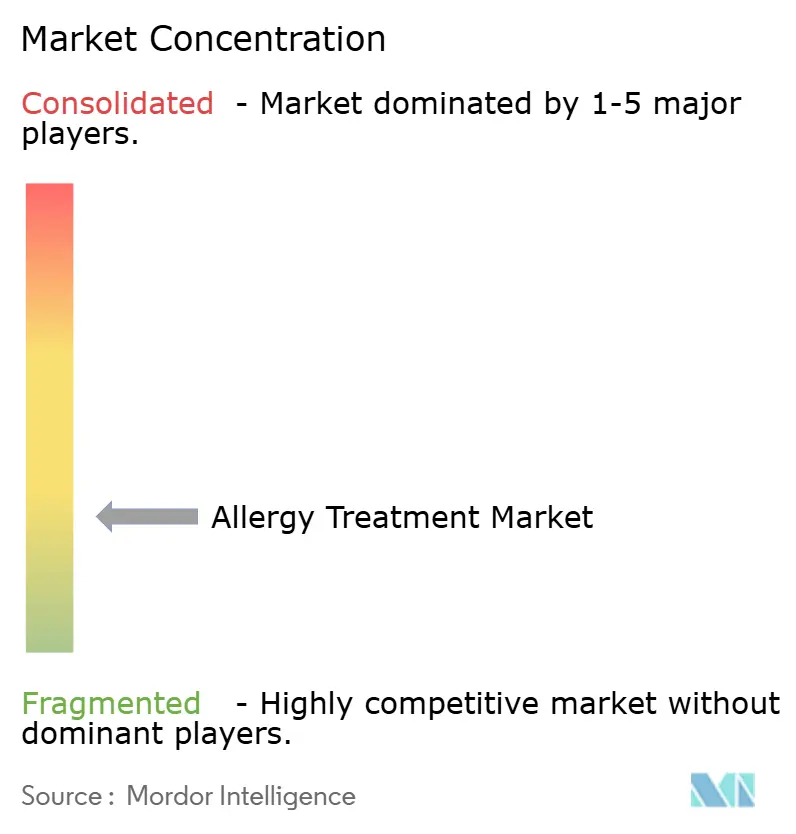
Recent Industry Developments
- June 2025: Sanofi acquired Blueprint Medicines for USD 9.1 billion, adding Ayvakit and early-stage immunology assets.
- April 2025: ALK-Abbello secured European approval for pediatric use of Itulazax tree-pollen SLIT tablet, aligning with the 2025/2026 season.
Global Allergy Treatment Market Report Scope
Allergy is a condition in which the immune system reacts abnormally to a foreign substance. Allergy treatment involves drugs and therapies that reduce the symptoms of allergies and help the immune system prepare for future encounters.
The allergy treatment market is segmented by type, treatment, and geography. By type, the market is segmented into eye allergy, rhinitis, asthma, skin allergy, and other allergies. By treatment, the market is segmented into anti-allergy drugs and immunotherapy. By geography, the market is segmented into North America, Europe, Asia-Pacific, Middle East and Africa, and South America). The market report also covers the estimated market sizes and trends for 17 countries across major regions globally. The report offers market size and forecast in terms of value (USD) for the above segments.
| Eye Allergy |
| Rhinitis |
| Asthma |
| Skin Allergy |
| Food Allergy |
| Other Allergies |
| Anti-Allergy Drugs | Antihistamines - 1st Gen |
| Antihistamines - 2nd/3rd Gen | |
| Corticosteroids - Topical, Inhaled, Systemic | |
| Decongestants - Oral, Nasal Spray | |
| Leukotriene Receptor Antagonists | |
| Biologics & mAbs | |
| Immunotherapy | Sub-cutaneous (SCIT) |
| Sub-lingual (SLIT - Tablets, Drops) |
| Tablets & Capsules |
| Nasal Sprays |
| Eye Drops |
| Inhalers |
| Injectables & Auto-injectors |
| Hospital Pharmacies |
| Retail Pharmacies & Drug Stores |
| Online Pharmacies |
| North America | United States |
| Canada | |
| Mexico | |
| Europe | Germany |
| United Kingdom | |
| France | |
| Italy | |
| Spain | |
| Rest of Europe | |
| Asia-Pacific | China |
| Japan | |
| India | |
| South Korea | |
| Australia | |
| Rest of Asia-Pacific | |
| Middle East and Africa | GCC |
| South Africa | |
| Rest of Middle East and Africa | |
| South America | Brazil |
| Argentina | |
| Rest of South America |
| By Allergy Type | Eye Allergy | |
| Rhinitis | ||
| Asthma | ||
| Skin Allergy | ||
| Food Allergy | ||
| Other Allergies | ||
| By Treatment | Anti-Allergy Drugs | Antihistamines - 1st Gen |
| Antihistamines - 2nd/3rd Gen | ||
| Corticosteroids - Topical, Inhaled, Systemic | ||
| Decongestants - Oral, Nasal Spray | ||
| Leukotriene Receptor Antagonists | ||
| Biologics & mAbs | ||
| Immunotherapy | Sub-cutaneous (SCIT) | |
| Sub-lingual (SLIT - Tablets, Drops) | ||
| By Dosage Form | Tablets & Capsules | |
| Nasal Sprays | ||
| Eye Drops | ||
| Inhalers | ||
| Injectables & Auto-injectors | ||
| By Distribution Channel | Hospital Pharmacies | |
| Retail Pharmacies & Drug Stores | ||
| Online Pharmacies | ||
| Geography | North America | United States |
| Canada | ||
| Mexico | ||
| Europe | Germany | |
| United Kingdom | ||
| France | ||
| Italy | ||
| Spain | ||
| Rest of Europe | ||
| Asia-Pacific | China | |
| Japan | ||
| India | ||
| South Korea | ||
| Australia | ||
| Rest of Asia-Pacific | ||
| Middle East and Africa | GCC | |
| South Africa | ||
| Rest of Middle East and Africa | ||
| South America | Brazil | |
| Argentina | ||
| Rest of South America | ||
Key Questions Answered in the Report
How large is the global Allergy treatment market in 2025?
It stands at USD 22.76 billion and is set to reach USD 33.59 billion by 2030.
Which therapy class is growing fastest?
Immunotherapy, particularly SLIT and biologics, is projected to register a 10.85% CAGR through 2030.
Why does Asia-Pacific record the quickest growth?
Rapid urbanization, extreme sensitization rates, and expanding insurance coverage drive a 9.85% CAGR.
What innovation addresses needle phobia in anaphylaxis care?
The EMA-approved nasal epinephrine spray (Eurneffy) delivers adrenaline without injections.
How are biosimilars influencing pricing?
Interchangeable omalizumab biosimilars slash costs by up to 40%, eroding originator margins yet widening access.
Which distribution channel is most dynamic?
Online pharmacies, supported by tele-care integration, are advancing at an 11.55% CAGR.
Page last updated on:
